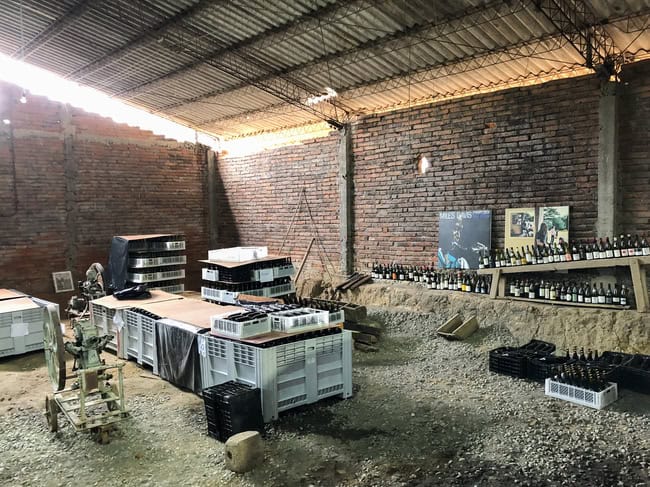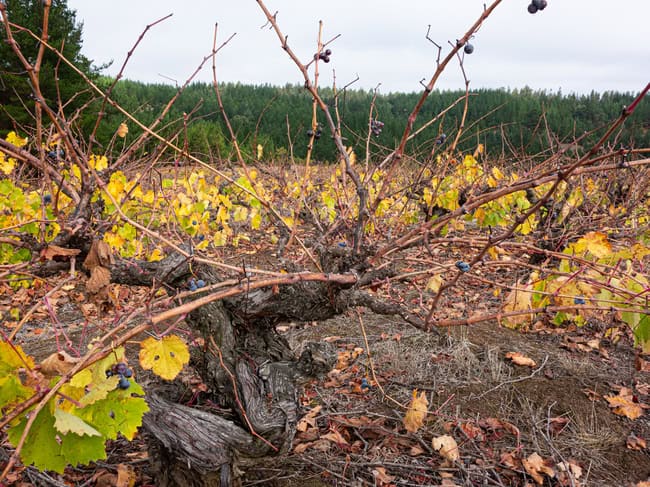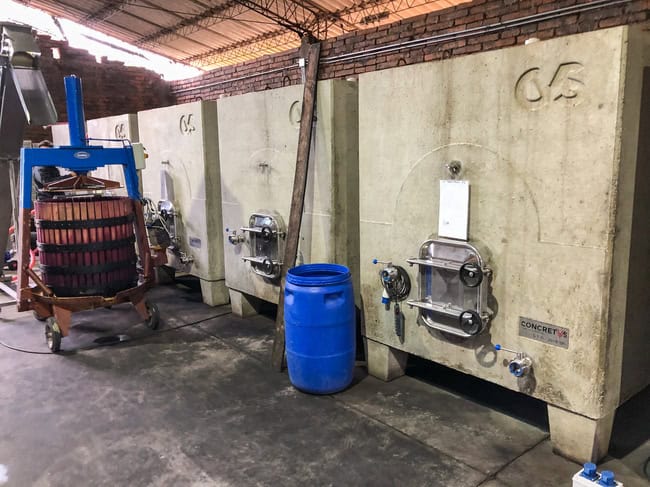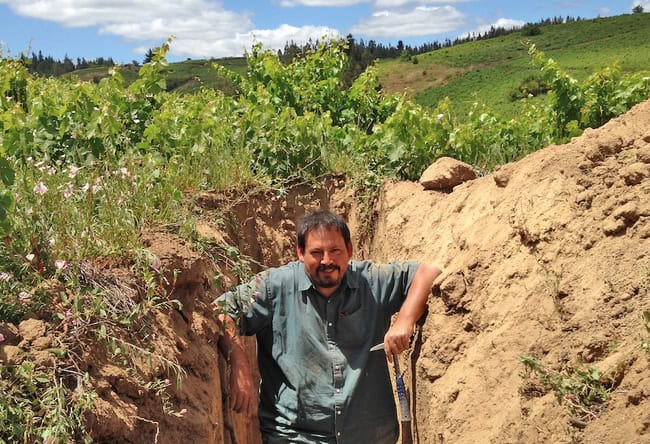The van bumps down the dirt road and comes to a halt at the top of a steep unmarked lane heading down the hill. The old woman with a walking stick who has stepped out of our way moves forward as she is hailed by the driver and asked if there is a winery down this road. “No,” she says with a wave, suggesting there might be one over that hill.
In the middle of Itata, the region that was described by a prominent Chilean wine guide in 2010 as “a backwater of a wine region,” we’re in search of what might be the only winery in Chile that my supremely well-traveled, wine-focused driver Alfonso Soto hasn’t visited. But his instincts are strong, and so we continue down the driveway despite the old woman’s suggestion, and quickly arrive at the rundown old winery that Pedro Parra has turned into a working cellar and rustic jazz lounge with a barbecue out back.

Parra has been well known in the wine world for many years, but not for making wine. Often referred to by his nickname, Dr. Terroir, he remains sought after the world over for his advice as a soil geologist to some of the most famous names in wine.
But 5 years ago, Parra decided that his deep study of terroir and its geologic underpinnings was not reaching its full expression in the dispensing of advice from the bottom of a soil pit.
‘Every time I was working, I got paid a little bit in wine,” he chuckles. “Also I started buying wine for my own cellar. It stopped being a job for me at some point, and became a funny way to drink a lot of wine.”
Parra realized that he wasn’t just in love with the soil, he was in love with wine. Around 2009 or 2010 he began to feel it wasn’t enough just to dig soil pits and tell people what they should be planting. He needed to make wine himself.
“I started really paying attention and talking longer with my clients, and I started having an opinion about what I wanted to do,” says Parra. ‘People know me because I am a consultant about terroir, but they don’t know that I think it is more important to be a producer.”

That impetus first took form in his investments in the wine projects Aristos and Clos de Fous, but after a couple of years, Parra realized that for what he really wanted to do, he needed to do it without partners.
“The older you get, the more you realize you don’t want to negotiate,” he laughs. “Now I know it is better without partners.”
So in 2013, he started making his own wines by renting space in the Clos de Fous facility and simultaneously began looking for a space of his own in the tiny region of Guarilihue (gwar-ee-lee-hway), the highly granitic section of the Itata Valley surrounding the town of the same name.
Despite his best intentions, but in accordance with his intuition and personal aesthetic, Parra ended up finding an abandoned stone building that the owner was willing to rent for a pittance. What the building lacked in stable electrical service and plumbing, it made up for in charm and a modest level of structural integrity.

‘The electricity is really a problem,’ laughs Parra, who attempts to describe the difference between the normal monophasic electricity found in most civilizations and the higher voltage, totally unreliable triphasic electricity he remains saddled with. “If you try to buy a destemmer you can’t buy a professional one, because it can’t handle the signal. You need to buy a smaller, amateur one, with very low quality.”
Apparently any professional level equipment will not only fail to function, it will likely bring down the entire tenuous electrical grid in the area, a lesson that Parra learned the hard way. Nonetheless, he is happy with his digs. “It is a good place,’ says Parra. “It is beautiful and I feel very at home. Not many people know the winery is here. It’s not that easy to get to. To me that’s OK. People aren’t going to come by and buy wines.”
Parra built a bathroom into the side of the building and poured a slab of concrete to hold some tanks. But before he did that, he installed a turntable and a good pair of speakers, and brought in a portion of his Jazz collection, which is on a constant rotation of play in the winery and serves as Parra’s muse in everything from the naming of his vineyards to his winemaking itself.
And what of that winemaking? It is born of one part intuition, one part careful listening to his clients over the years, and one part which is an undeniable belief in listening to what the soil tells him.
“As a consultant when I approach a terroir that is unique, I get a picture in my head — a sense of the wine and what its potential can be,’ explains Parra. ‘Sometimes it happens and sometimes it doesn’t but I get this sense of what kind of wine should be made from this place.’
For Parra, that picture of a wine is mostly about texture and sensation, and this is where the Jazz comes in. “I don’t pay a lot of attention to flavors,” says Parra, “You’re going to get them no matter what, and they can be manipulated. More important is what happens in the mouth. The tension, the grip, the vector of the wine — where you get energy in your mouth.”

“The real music is the silence and all the notes are only framing this silence,” said Miles Davis, famously cribbing a quote from composer Claude Debussy. “Miles Davis pays with the silence,” says Parra. “It’s the most difficult note to play.”
For Parra, the sensations he is looking for come from rock, and what that rock makes possible.
“I care about granite,” says Parra, “The grape is secondary. You need to have old vines, carefully tended, working the vineyard to avoid compacted soil and to get deep roots. I don’t care if it is Cinsault or Pais, I just want it to have character.”
The intricately broken gullies and hills of the Guarilihue region of Itata offer Parra the apotheosis of everything he seeks in his raw materials. The area sits on a massive and ancient upwelling of granite that is the result of the tectonic processes which gave Chile its mountains and volcanoes. 100 million years ago, says Parra, Itata was a mountainous region, 1400 meters high. Now erosion has brought those mountains down to the 200-meter-tall knobby ridges and knolls of Guarilihue, where thin layers of very sandy clay sits directly on top of the slowly decomposing rock. This sand, Parra maintains is the reason that the Cinsault and Pais vines that farmers planted more than 100 years ago still thrive.

“Itata is good because of the quartz sand,” says Parra. “It creates the porosity in the soil, the drainage and the resistance to compaction, giving drainage and room for the the old roots to find the rock. Quartz means air.”

Parra has found pockets of some of the oldest Cinsault and Pais in the Guarilihue region that he has decided to treat as individual “crus,” seeking to express what each plot has to say through its soils and aspect. All are filled with head-trained vines, most in excess of 80 years old, with many over 150. Because he doesn’t own these plots, the past few years have been a journey to getting the farmers to move to a fully organic regimen, with hopes that 2020 will be the first vintage without the use of any chemicals. Still, he is able to farm almost entirely with a horse, rather than tractor, and to harvest carefully by hand with the help of the farmers and his friends and family. At first, the fruit from these vineyards went into two blends “Imaginador” and “Pencopolitano” but as of last year, Parra began releasing “single cru” wines from each, named after some of his Jazz heroes: “Trane” for John Coltrane, “Hub” for Freddie Hubbard, “Monk” for Thelonius Monk. One for Miles Davis is apparently on the horizon.

Parra’s winemaking, accomplished lately with the help of assistant Felipe Ignacio Carte, consists of fairly rudimentary regimens. The grapes come into the winery in small batches corresponding to the vineyard blocks. Much of the Pais is destemmed, but increasingly a portion of the Cinsault is not. Parra has been falling more in love with whole cluster fermentation, especially for the Cinsault whose natural sweetness Parra thinks is nicely mediated by the herbal quality of its stems. After a relatively cool fermentation in either concrete or steel tanks with ambient yeasts, the wine is pressed and both the free-run and press fractions are put back into tank to go through malolactic fermentation. The wines are racked off their lees, “when they start to taste reductive” says Cartes, who indicates that most wines get two rackings before bottling and spend about a year in tanks during that time.

I had the opportunity to taste the second vintage of Parra’s single-cru wines along with his two blends on my visit this past Spring, and I’ve been trying to decide the best way to characterize just how electrifying the experience was. These wines are quite simply the most exciting wines I’ve ever tasted from Chile, and have completely reset my understanding of what Chile may be capable in terms of expression of terroir.
To the extent that they represent the practical application of Parra’s theories when it comes to soil and terroir, I couldn’t imagine a more thorough and powerful validation of his work as a soil geologist. The wines are quite simply a triumph. No one will ever be able to say that Dr. Terroir hasn’t earned his nickname in full.

Tasting Notes
2017 Pedro Parra y Familia “Imaginador” Cinsault, Itata Valley, Chile
Medium garnet in color, this wine smells of exotic flowers, mulberries and cherry. In the mouth, fantastically bright and juicy flavors of mulberry and herbs are incredibly aromatic with faint powdery tannins. Remarkable and delicious. Incredible acidity and length. 100% Cinsault with about 15% whole cluster fermentation. 14% alcohol. This is Parra’s first commercial release. Score: around 9.5. Cost: $26. click to buy.
2017 Pedro Parra y Familia “Pencopolitano” Red Blend, Itata Valley, Chile
Medium garnet in the glass, this wine is sweetly aromatic with aromas of berries and flowers. In the mouth, gorgeously mineral and bright flavors of berries and flowers and a gorgeous savory slightly salty note swirl with incredible acidity and gorgeous texture. Fine grained tannins. 55% Pais, 45% Cinsault, with about 15% whole cluster fermentation. Pencopolitano is the colloquial term for the local farmers. Score: around 9.5. Cost: $26. click to buy.
2018 Pedro Parra y Familia “Imaginador” Cinsault, Itata Valley, Chile
Medium garnet in color, this wine smells of smoky, spicy, meaty deliciousness layered over bright red and blue fruits. In the mouth berries and savory notes are nicely balanced, wrapped in a skein of fine grained tannins. Great acidity and deep stony minerality. Herbs and hints of bacon swirl through the crystalline finish. Gorgeous. Roughly 30% whole-cluster fermentation. 13.5% alcohol. Score: around 9.5. Cost: $26. click to buy.
2018 Pedro Parra y Familia “Pencopolitano” Red Blend, Itata Valley, Chile
Medium garnet in color, this wine smells of earth and wet bark and flowers. In the mouth, savory notes of dried herbs, forest berries and earth have an intense spiciness and deep mineral depth. Penetrating and powerful, with amazing depth and complexity. Incredible. Roughly 30% whole-cluster fermentation 13.5% alcohol. Score: around 9.5. Cost: $26. click to buy.
2018 Pedro Parra y Familia “Trane” Cinsault, Itata Valley, Chile
Light to medium garnet headed towards royal purple in the glass, this wine smells of meaty bacon and exotic herbs. In the mouth, intensely bright mulberry and elderberry fruit flavors mix with deep minerality and saltiness. Exceptionally gorgeous. Fine grained tannins coat the mouth and seem to flex their muscles in slow motion as a technicolor swirl of savory fruit and herbs lasts for minutes in the finish. 100% Cinsault with at least 30% whole-cluster fermentation. 13.5% alcohol. Score: between 9.5 and 10. Cost: $42. click to buy.
2018 Pedro Parra y Familia “Hub” Cinsault, Itata Valley, Chile
Medium garnet in color, this wine smells of boysenberry, plum, wet slate and crushed herbs. In the mouth, deeply mineral flavors of wet stone, boysenberry and flower petals are gorgeous, deeply mineral, and mysterious. Seems like the bud of a flower waiting to open. Fantastic wine. Roughly 30% whole-cluster fermentation 13.5% alcohol. Score: around 9.5. Cost: $42. click to buy.
2018 Pedro Parra y Familia “Monk” Cinsault, Itata Valley, Chile
Medium garnet in the glass, this wine smells of smoked bacon and chopped herbs. In the mouth, intense berries, plums and fresh herbs mix with a deep stony minerality that has an extraordinary depth with a hint of spiciness. Plum and plum skin linger in the finish with a wet chalkboard minerality and fine grained, dusty tannins. Deep and ever-so-stony. A stupendous wine. 100% Cinsault with roughly 30% whole-cluster fermentation13.5% alcohol. Score: between 9.5 and 10. Cost: $42. click to buy.
Parra’s wines are imported to the US by Skurnik Wines.